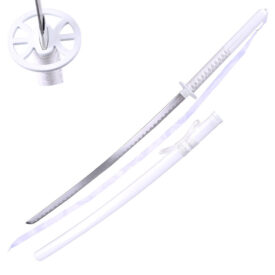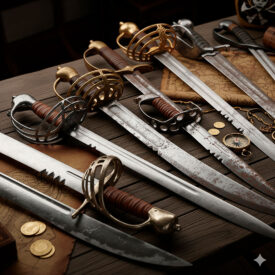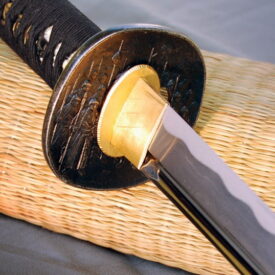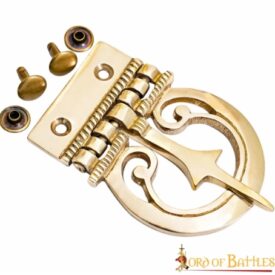Swords have captivated the human imagination throughout history, appearing in epic tales, movies, and video games. However, beyond their romantic aura and decorative use, there is a category of swords designed with a very specific purpose: functionality. For enthusiasts, practitioners, or collectors, understanding the essence of a functional sword is key to appreciating its true nature and value.
What Defines a Functional Sword?
A functional sword stands out for its specific design and construction to be actively used, whether for practice, training, combat, or historical reenactment. Unlike a purely decorative sword, which serves only as ornament, a functional sword is made with high-quality materials and follows rigorous standards of strength and durability. Holding one of these pieces in hand is a very different experience; its weight, balance, and solid construction give a sense of reality and purpose, very different from purely display swords.
The essential features of a functional sword include:
- Sharp and Resistant Blade: Its blade is designed to cut and pierce efficiently. It is made of high-quality steels and undergoes heat treatments to ensure its strength and durability.
- Ergonomic Grip: The handle must be comfortable and secure, often wrapped in leather or fabric to provide a firm hold.
- Optimal Balance and Weight: A functional sword has the proper balance between blade and handle, allowing for precise and agile movements. Its weight is suitable for the user, preventing it from being too heavy and hard to maneuver.
- Solid Guard and Pommel: The guard protects the hand, while the pommel at the end of the handle helps balance the sword. Both must be firmly attached and robust.
The History and Evolution of Functional Swords
The history of functional swords is as ancient as civilizations themselves, evolving from the Bronze Age to the Iron Age, where advances in metallurgy enabled the creation of longer and stronger blades. Diverse cultures, from Roman to Japanese, developed their own styles and techniques, perfecting design and materials to maximize their effectiveness in combat. These objects are not just tools—they carry deep cultural meaning and symbolism.
Essential Materials for an Authentic Functional Sword
The choice of material is fundamental for the quality of a functional sword. Steel is key, but not all steels are the same.
Common Types of Steel
- Carbon Steel: The preferred option for its strength, durability, and ability to hold a sharp edge for a long time. However, it is more susceptible to rust and requires more frequent maintenance.
- Damascus Steel: Known for its distinctive wavy patterns and renowned toughness, Damascus steel can be extremely strong and sharp. However, in lower-cost swords, “Damascus” or “folded” steel may introduce points of failure.
- Stainless Steel: While resistant to corrosion and easy to maintain, it is generally less durable and more brittle for functional swords. It is not recommended for this purpose in most cases.
The Importance of the Tang and Pommel
The tang is the part of the blade that extends inside the handle. For a functional sword, it should be wide and sturdy, preferably running through the entire handle (full tang) and fixed to the pommel. Decorative swords often use “rat-tails,” thin and weak tangs that can break on impact. The pommel, in addition to its balance function, is crucial for securing the handle to the tang, whether riveted (the most resistant and permanent method) or screwed, which is strong and removable.
Steel Heat Treatments
Heat treatment transforms forged steel into a strong blade. Processes like tempering and annealing are vital to improve hardness and flexibility, ensuring the sword can withstand use without breaking. Some blades may have differential hardening (hard edge, soft spine) or uniform hardening (even hardness across the whole blade).
Types of Functional Swords and Their Uses
Functional swords are classified according to their purpose:
- Combat Swords: Designed for real battle, focused on cutting, thrusting, and blocking attacks. These are recognized by their carbon steel blades and great strength.
- Practice (or Training) Swords: With unsharpened blades or rounded tips, they minimize injury risk during fencing and historical martial arts practice.
- Cutting Swords: Used in demonstrations to perform precise cuts in materials like tatami or bamboo, requiring excellent balance and technique.
In addition, there are specific types depending on their design and era, such as the longsword, bastard sword, Japanese katana, saber, or rapier, each with its own construction and handling characteristics.
A Closer Look at Combat Functional Swords
Swords with carbon steel blades, full tangs (Full Tang), and greater resilience for the most demanding close combat. These are some of the features required for a training sword (battle ready).
One visible difference from decorative swords is the lack of engraving or decorations along the blade. The sobriety of the elements is another typical trait. Some are made with an antiqued blade. Here are some examples of functional combat swords.
At Tienda-Medieval we offer you the best and most varied selection of Functional Combat Swords, many manufactured in Toledo (Spain).
Caring for and Maintaining Your Functional Sword
Proper maintenance not only preserves the beauty of your sword, but is vital for its longevity and safety. A functional sword is an investment, and as such, it requires care.
Cleaning and Drying
Cleaning is the most important step after each use, even if dirt is not visible, to remove fingerprints, sweat, and moisture. Use a soft, dry cloth, and for more stubborn dirt, a slightly damp cloth or a mild cleaner. Make sure to fully dry the blade immediately. A common mistake is to clean only the blade, but you must also pay attention to the guard and pommel.
Rust Prevention and Treatment
Rust is steel’s biggest enemy, caused by the reaction of iron with oxygen and moisture.
- Prevention: Regular cleaning and drying are key. A thin layer of acid-free oil (like camellia oil or special weapon oils) creates a protective barrier. Store the sword in a dry environment and avoid leather sheaths or fabric covers for long periods.
- Removing Light Rust: For superficial rust, a soft cloth with a bit of oil may be enough. Fine steel wool (grade 0000) or baking soda pastes can help; always rub gently in the direction of the blade, then clean, dry, and oil again.
- Treating Heavy Rust: Severe rust can compromise the structure of the blade. Professional help is recommended.
Sharpening and Polishing
These tasks require skill and patience. If you don’t feel confident, it is better to consult a professional for valuable or complex pieces.
- When to Sharpen: Sharpen your sword when it loses its edge or has small nicks. A simple test is to try cutting a sheet of paper.
- Techniques: You can use a whetstone or seek professional sharpening. Excessive sharpening can damage the blade’s geometry.
- Polishing: Polishing gives shine and helps seal the surface, hindering corrosion. Use special polishing pastes and soft cloths.
Caring for the Handle and Scabbard
The handle and scabbard also need attention. Wooden ones should be treated with linseed oil occasionally, while leather ones require specific products to keep them flexible. Never store the sword in a damp scabbard, as this can cause rust.
Safety First: Handling Functional Swords
Handling functional swords, even if they are primarily for collection, always requires extreme caution.
Handling Sharp Blades
Never touch the blade directly; always use the handle. When cleaning or oiling, always work away from your body, on a stable surface, and without other people—especially children—nearby. Store swords out of reach of children, ideally locked away. Be aware of the sword’s weight and length to avoid accidents.
Personal Protective Equipment
It is essential to use cut-resistant gloves and safety glasses to protect the eyes from splashes, and to work in a well-ventilated area when using chemicals. Tight-fitting, long-sleeved clothing offers better protection.
Common Mistakes to Avoid and When to Seek Professional Help
To keep your sword in optimal condition, avoid these frequent mistakes:
- Excess Oil: Too much oil can attract dirt and dust, which strangely can cause rust. Apply only a thin, even layer, removing the excess.
- Inadequate Cleaning Products: Harsh or acidic cleaners can damage the blade’s surface. Use mild, neutral pH soaps or warm water.
- Neglecting the Handle: Don’t focus only on the blade. The handle, whether wood or leather, needs regular cleaning and treatment to avoid drying out, cracking, or deteriorating, which could affect safety.
Despite meticulous care, there may be situations that require expert intervention, especially in cases of severe rust, structural damage, or if you have valuable historical pieces. A professional blacksmith or restorer has the knowledge and tools to make complex repairs and restore historical items.
Caring for a functional sword is more than a simple task; it is an art and an expression of respect for the craftsmanship and the rich history embodied in each piece. Regular maintenance not only preserves the sword’s value, prolongs its useful life, and ensures its functionality, but also prevents costly repairs and allows you to fully enjoy the beauty of a well-maintained blade.
If you are looking for the perfect piece for your collection or practice, we invite you to SEE MORE FUNCTIONAL COMBAT SWORDS in our selection, where you will find high-quality swords, many made in Toledo, the sword capital.











